The primary treatment and ligation of the umbilical cord is carried out even in the maternity hospital after the complete cessation of the pulsation of its vessels, which usually occurs 2-3 minutes after the birth of the fetus. Before crossing the umbilical cord, it is wiped with alcohol and two sterile clamps are applied at a distance of 10 and 2 cm from the umbilical ring. The umbilical cord between the clamps is treated with 5% iodine solution and crossed with sterile scissors. In this place, the umbilical stump (residue) remains, which dries up and falls off on its own naturally after a few days. The umbilical cord is cared for by a doctor.
There is no need to keep the baby in the hospital until the rest of the umbilical cord falls off. This is even reflected in Order No. 345 of the Ministry of Health of the Russian Federation “On improving measures to prevent nosocomial infections in obstetric hospitals”: “From an epidemiological point of view, a course for early discharge (2-4 days after childbirth), including before the umbilical cord falls off, is justified.”
However, in the history of the development of a newborn, one can often read "the umbilical cord fell off on the second day." In life, surgical removal is practiced - cutting off or unscrewing the umbilical cord residue after the newborn has two full days of life. This is due to the fact that not even all district pediatricians and patronage nurses are ready for a child with a bracket to come under their supervision, not to mention a young mother.
So, by the time of discharge from the hospital, as a rule, the umbilical cord is no longer there, but there is an umbilical wound, or rather, a scar (navel), which must be carefully looked after. This area must be kept clean and dry at all times. To reduce the risk of infection of the umbilical wound and in order to prevent purulent diseases of the navel and the development of umbilical sepsis (in which the infection enters the bloodstream, causing infection of the whole body), it is necessary to treat the umbilical wound twice a day (in the morning during the first swaddling and in the evening after bathing).

For processing umbilical wound you will need sterile cotton swabs, 3% hydrogen peroxide solution, alcohol infusion of greenery (or 5% potassium permanganate solution or 5% iodine solution).
Wash your hands thoroughly before handling the navel. Big and index fingers grab the skin around the navel and open the wound a little. Moisten a cotton swab or drip a few drops of a 3% hydrogen peroxide solution and treat the wound from the center to the outer edges, carefully removing the wound discharge, while the peroxide will foam. Dry (wetting movements) with a sterile cotton ball. After that, we treat the umbilical wound with an antiseptic solution: iodine or brilliant green, or potassium permanganate. It should be noted that a solution of brilliant green causes weeping, and a solution of potassium permanganate (potassium permanganate) dries. Therefore, it is better to treat the wound with potassium permanganate.
It is necessary to treat the umbilical wound until the navel heals and there are no crusts, serous or sanious secretions, and when treated with peroxide, foam does not form.
As a rule, the umbilical wound heals (epithelializes) by the end of the second week of life, while the skin umbilical ring contracts.

By the age of 2 weeks, the child will be a normal navel, the shape of which, by the way, does not depend on the skill of the one who cuts the umbilical cord, but depends solely on the individuality of the child himself.
If the wound begins to get wet, discharge appears, and the surrounding skin turns red, it is quite possible that an infection has got into it - in this case, call a doctor immediately!
Bathe the baby until the umbilical wound has healed, should be in water with the addition of a weak solution of potassium permanganate.
Before each dressing, leave the umbilical wound open so that there is air access - this way it is easier to keep it dry.
Do not put a patch on the umbilical wound, as the baby's skin does not breathe through it and this can cause irritation of the skin.
Possible use disposable diapers with a special cutout for the navel, so the edges of the diaper will not touch the umbilical wound to avoid chafing, and the top layer closes the cutout and protects this place from moisture and infections.
© Copyright: site
Any copying of material without consent is prohibited.
Absolutely all young mothers face the procedure for processing the navel in a newborn. At the same time, they have a lot of questions regarding how this procedure should be carried out.
We invite you to look below video "How to handle the navel of a newborn", and find out the advice of pediatricians on how to properly treat the navel, what is needed for this, as well as what to do if the navel bleeds, and in which cases you should see a doctor as soon as possible.
After the baby is born, the umbilical cord is cut almost immediately. The umbilical cord is the link between the fetus and mother. The resulting wound must be carefully treated, up to its complete healing. The goal of caring for a newborn's navel is to prevent bacteria from entering the open wound, that is, to avoid infection.
So, in order to process the navel of the baby, you will need:
- hydrogen peroxide 3%;
- brilliant green;
- pipette, cotton swabs and disks.
How to treat the navel of a newborn
A crust forms on the navel of the newborn. And it needs to be removed. Just do not pick or tear off in any case. To properly remove the crust, it must first be thoroughly softened using hydrogen peroxide for this purpose.
The treatment of the navel is carried out in three stages:
- Stage 1: crust softening. To soften the crust, put a couple of drops of peroxide on it from a pipette. You can also moisten a cotton pad with peroxide, and simply attach it to the wound.
- Stage 2: crust removal. It is easiest to remove crusts from the navel with a cotton swab.
- Stage 3: treatment of the wound with brilliant green. Take a clean stick and wet it with green paint. Treat only those places where the wound has not yet healed. Applying brilliant green to healthy skin is not worth it!
How to handle the navel of a newborn video:
Why does the navel bleed in a newborn?
Sometimes a wound on the navel may not heal for a long time (), and even bleed. There may be several reasons for this:
- too thick umbilical cord, which always heals longer;
- early laying out of the newborn on the stomach;
- strong crying, as a result of which the navel may crack and begin to bleed;
- trauma to the umbilical wound with a diaper, diaper, clothes, or due to inaccurate handling.
What to do if the navel bleeds? A bleeding wound must first be treated with peroxide, and then dried with a gauze cloth. Then process with greenery.
When to see a doctor?
The help of a child specialist is needed if:
All these symptoms may indicate that the umbilical wound is infected, which requires medical intervention. Therefore, urgent medical attention is essential!
When should the navel of a newborn heal? We strengthen nervous system child Baby massage for hip dysplasia (video) Cough in the chest: possible reasons and methods of treatment How to do a relaxing breast massage
During pregnancy, the child is connected to the mother by the umbilical cord, through which the necessary substances and oxygen enter his body. From the moment of birth, the child's organs begin to fully function, and the umbilical cord, as unnecessary, is cut and tied. A small part of it remains with the baby.
After a while, it will dry out and fall off, leaving an umbilical wound. How many days it will take depends on the individual characteristics of the body, the thickness of the umbilical cord. This usually happens after 2-3 days, sometimes the process takes about a week. Less commonly, there is a need to remove the remnant of the umbilical cord surgically.
What to do with an umbilical wound?
While the mother and child are in the hospital, medical staff helps to monitor the navel. At home, you will need to take care of the baby yourself. Most often, the wound heals after 3 to 4 weeks. In order for the navel to heal faster, certain rules must be followed:
- The wound cannot be wetted. It is strongly not recommended to bathe a child in a common bath until the navel is healed, because pathogenic bacteria can enter the bloodstream through it. A weakened organism is not always able to cope with them;
- It is necessary to bathe the newborn in boiled water, you can add a little. It is necessary to ensure that water does not enter the wound, in the first weeks of life it is not necessary to wet the child completely, it is enough to wipe it with a wet washcloth made of soft material.
- Once a day, after bathing, it is necessary to treat the navel with drying antiseptic agents. An alcohol solution of brilliant green (brilliant green) and hydrogen peroxide are used. You can replace greenery with. With a weeping navel, it is necessary to treat the wound more often - up to 3 times a day.
- In order for the navel to dry out, it needs air. It is necessary to ensure that the wound does not come into contact with tight clothes and is not rubbed with a diaper. You can purchase special models that have a hole for the navel, or bend the edge of the usual ones.
- It is necessary in a timely manner so that urine does not get into the wound. If the navel is still wet, you need to gently wipe it with a swab and an antiseptic.
- You can not lubricate the wound with baby hygiene products - creams, oils. They help with diaper rash, but interfere with the healing of the wound, block the access of oxygen to it and contribute to the reproduction of microbes.
How long to treat an umbilical wound depends on the speed of healing. At first, the umbilical wound may bleed a little, but then it passes. A month after birth, she completely heals and is cleared of crusts.
Warning symptoms
You need to carefully monitor the condition of the wound and pay attention to the symptoms:
- Around the navel there is swelling, redness;
- The wound smells unpleasant;
- The navel is bleeding;
- Pus is released from the wound, it begins to get wet.
If one or more signs are observed, you should contact your pediatrician.
Processing method with greenery

Zelenka (2%) is more often used to dry the navel. You will also need hydrogen peroxide (3%), sterile cotton swabs and napkins or cotton swabs. You need to prepare everything in advance so as not to be distracted in the process. Processing procedure:
- Be sure to wash your hands with soap to avoid infection;
- Depending on the structure, the navel can be covered with skin, which needs to be pulled back a little with your fingers to treat the wound;
- It is necessary to wet the crusts with hydrogen peroxide (soaked ones are easier to remove). You can do this with a pipette - drop a few drops, or sterile cotton wool, a cotton pad - moisten well and apply to the wound. Until it drags on, the peroxide, when interacting with the ichor, hisses and foams a little;
- You need to wait, then with a cotton swab or disc slightly dipped in peroxide, gently clean the navel from the crusts. You can not rip off dry formations - this can open a wound, injure the skin and prevent healing;
- Lubricate the cleaned wound with brilliant green. It is convenient to use the tool in the form of a pencil with an applicator. It is necessary to treat the wound itself, the skin around the navel does not need to be lubricated. So brilliant green will not interfere with monitoring the condition of the baby and will allow you to notice signs of inflammation in a timely manner - redness, swelling.
It is necessary to handle the navel of a newborn carefully, without pressure, to remove only those crusts that are easy to remove. You can not scratch the skin and strive to completely clean the navel.
After treating the navel, it is necessary to provide air access to the wound so that it dries up. Air baths help speed up healing. Newborn clothes should be made of natural breathable fabrics, without seams in the navel area. It is better to iron it on both sides to reduce the amount of germs. 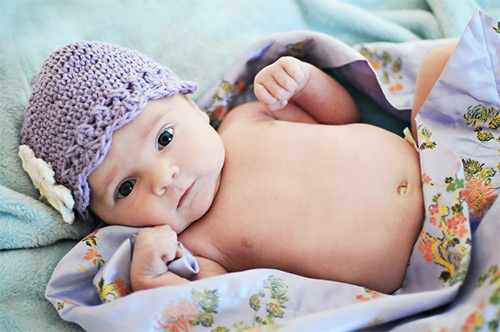
It is a herbal preparation made from eucalyptus leaves. Chlorophyllipt has anti-inflammatory properties, kills microbes, and is effective in the fight against staphylococci. The product is available in the form of tablets, spray, oil and alcohol solution.
Oil-based chlorophyllipt cannot be used to treat the navel; an alcohol 1% solution is required. The product has a transparent green color therefore does not leave stains on the skin of the baby. Chlorophyllipt is used as well as brilliant green for the navel. Or you can drip it onto the wound with a pipette, removing excess with sterile cotton.
What other means can be used?

There are several antiseptics that can replace brilliant green:
Manganese
Applied, you need to make it yourself. Dissolve the crystals in boiled water until desired color, then strain so that no whole particles of the substance remain. They may cause burns if they come into contact with the skin. Put a couple of drops of liquid into the wound. The finished solution is stored for up to 10 days.
Fukortsin
A strong antimicrobial agent, available in the form of an alcohol or aqueous solution, can cause allergies. It can be used only as prescribed by a doctor for complications of the umbilical wound - jamming, infection. It is applied once a day after cleansing the wound with a solution of hydrogen peroxide.
Chlorhexidine
It has good antiseptic properties, but it dries out the skin, causes itching and irritation. It can be used to disinfect the umbilical wound, but you need to monitor the reaction of the baby's skin. Suitable for cases when there are no other means for treating the navel at hand.
Iodine
Before use, you need to clean the navel with hydrogen peroxide. Only the wound itself needs to be treated with iodine, since the product dries the skin very much. If you smear the skin around the navel, the child may get burned.
Furacilin
For application it is necessary to dissolve boiled water. The resulting solution is dripped onto the cleaned umbilical wound. It is safe for the baby, fights germs, helps with a weeping navel.
streptocide
The powder is used for inflammation of the umbilical wound. A little money is poured onto the wound cleansed of pus and crusts.
Tincture of calendula
It has a disinfectant effect, promotes wound healing. It is used, like brilliant green, after cleansing the navel from dry formations.
Alcohol should not be used to treat the navel, it can dry out the skin, cause irritation and burns. To decide which drug is more suitable, you need to consult a doctor, especially if complications arise.
- And now you can no longer afford to wear open swimsuits and short shorts ...
- You start to forget those moments when men complimented your flawless figure...
- Every time you approach the mirror, it seems to you that the old days will never return ...
As soon as the baby is born, his physical connection with the mother is interrupted. Doctors cut the umbilical cord, and for the next few weeks, the parents must make sure that the wound heals as soon as possible. To do this, you need to know: how and how to treat an unhealed navel in a newborn. If all manipulations are performed properly, there will be no problems.
The timing of the healing of the umbilical wound
Timely drying and healing of the wound is an indicator that everything is normal. Usually, it takes no more than a month for the incision to heal completely.
It is difficult to specify specific dates, because the amount of time required depends on several factors, such as the size of the umbilical cord, the immunity of the newborn, etc.
Wound healing occurs in several stages. First, in newborns, the remaining part of the umbilical cord should dry out. Around the fifth day, it falls off on its own. Then you need to take care of tightening the wound and preventing the development of inflammation. Over the next 2 - 3 weeks, it is necessary to properly handle the baby's navel. If stick general rules hygiene during this period, the result will soon be noticeable.
How many days to process the child's tummy depends on the degree of wound healing. Usually, by the end of the first month of life, the navel in newborns is completely tightened and no longer requires increased attention. Dates may shift by a few days, but in general remain common for all children.
How to handle baby's navel
Processing a baby's tummy is a very responsible business. They start it in the hospital. Immediately after the baby is born, the umbilical cord is cut off. Do this after a few minutes to slow down the blood flow. The tube is pulled with a thread or a clamp and its excess is cut off. Primary treatment consists in lubricating the umbilical cord with alcohol, and the wound with brilliant green. Sometimes newborns can cut the remnants of the umbilical cord with a blade after a couple of days. After discharge from the hospital, the task of treating the navel of the crumbs falls entirely on the shoulders of the parents.
After the baby has been discharged from the hospital, caring for the umbilical wound is completely the concern of the parents.
Subsequent manipulations consist in lubricating the tummy with special preparations and general antiseptics. What is the best way to treat a wound in a given period of time?
In the early days, while the umbilical cord has not yet fallen off, it is better to treat it with brilliant green or iodine. After the navel is freed from excess, new drugs are used. Before carrying out manipulations, it is necessary to bathe the newborn, while prolonged contact with water is undesirable. The best solution would be to prepare a bath with warm boiled water and potassium permanganate.
After water procedures a little hydrogen peroxide should be dripped into the wound with a pipette. Upon contact with bloody secretions or ichor, it will hiss. Then clean the baby's navel with a cotton swab. So it will be possible to remove dirt and soaked crusts. After that, treat the unhealed place with brilliant green. Painting over the skin around the navel is undesirable, as you can miss the development of inflammation.

The navel should be treated after the baby's water procedures
You can also use chlorophyllipt to speed up healing. This is an excellent antimicrobial agent, even for the smallest. But if there are difficulties, most likely, you will need to treat the wound with baneocin. This antiseptic is often used to heal surgical sutures.
Until the wound on the tummy is completely closed, in no case should one allow debate and violate hygiene standards. Dress your child in clothes made from natural breathable fabrics. The diaper should not touch the navel. Also, do not stick it with a band-aid and scrub it too hard or peel off the crusts. Do not use too many drugs, one or two will be enough. In addition, you do not need to lubricate the wound too often, so as not to damage the delicate skin on the tummy and not lead to its excessive dryness. It is better to put on the tummy of a newborn after the wound has completely healed.
What to do if the wound does not heal
Even if you process the baby's navel according to all the rules, there is no one hundred percent guarantee that everything will go perfectly. Sometimes, for one reason or another, complications arise, the wound begins to bleed, rot, or does not heal for a long time. Usually the reasons that the navel does not heal for a long time are:
- insufficient air supply, debate;
- damage to the crust during manipulations;
- weakened immunity of the newborn;
- non-compliance with hygiene standards;
- getting into the wound infection;
- thick umbilical cord and big size navel.
If the navel is treated incorrectly or completely ignored this procedure, it is very likely that an infection can be introduced into the wound and an inflammatory process will begin. Such a problem is indicated bloody issues, suppuration, moisture of the skin, its redness and itching, swelling, unpleasant odor, anxiety of the child. In this case, you should immediately contact pediatrician. If the belly button has increased in size and become bulging during the healing process, this may indicate an umbilical hernia.
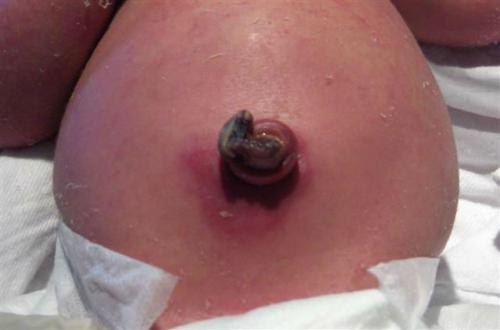
If you ignore the treatment of the umbilical wound or do it incorrectly, then there is a high risk of developing inflammatory diseases of the navel, up to sepsis
After the doctor's observations, the necessary actions in a particular case will be carried out. Subsequently, it will be necessary to process the wound according to the previous scheme. In severe cases, antibiotic ointments may be prescribed. You may need hospital treatment.
To avoid all this, with any suspicion of a problem or with a delay in the healing of the navel, it is worth making a visit to the clinic. Self-medication is not worth it, this can lead to complications and the development of omphalitis.
In order for the child to remain healthy and cheerful from the first days, it is necessary to adhere to the rules of hygiene. Timely treatment of the umbilical wound of newborns is very important, because any infection or even a slight inflammation can lead to serious complications. Therefore, monitor the condition of the child's navel, do not forget to lubricate it with antiseptic preparations and do not delay a visit to the doctor if something suddenly goes wrong. The health of your child depends on you.
When the baby is born, the connection through the umbilical cord stops. The umbilical cord is clamped with a special clamp and cut. Thus, the supply of blood through the vessels is stopped. The newborn's navel should be treated with a clothespin until it is completely healed.
How to care for the navel of a newborn with a clothespin?
What does a navel with a clothespin look like? When the umbilical cord is cut, an open wound is formed. For quick healing, use a clip - a clothespin. The product is made of plastic, does not bring discomfort to the child.
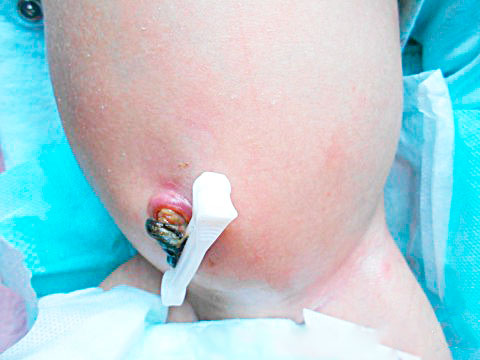
Clothespin on the navel of a newborn photo
In the maternity hospital, the remains of the umbilical cord undergo additional processing. As a result, a small piece two centimeters long remains from it. The rest of the umbilical cord is clamped with a plastic, very rarely, a metal clamp. The wound will heal in the future and a full-fledged navel is formed. To speed up the healing process, it is necessary to treat the navel in newborns with a clothespin.
How does the navel heal in a newborn with a clothespin? After some time, the rest of the navel above the clamp becomes more and more dry. This process is facilitated by careful care of the navel of a newborn with a clothespin.
After a week, the umbilical cord of most babies takes the form of a dry, hard, inanimate tissue. Further, it falls off along with the bracket that clamped it. An umbilical wound is formed. If the baby had a thicker umbilical cord after birth, then it dries out a little longer, about 10 days.

Do I need to treat the navel with a clothespin? Treating the baby's navel with a clip is essential. Proper care heals the wound, stops the discharge, prevents the penetration of bacteria. Don't be intimidated by a newborn's belly button, it's very easy to care for.
The absence of discharge from the wound, the falling off of the formed crust - says that the navel with a clothespin heals safely.
There are times when the crust falls off and a few drops of blood are released. At the same time, with the help of hydrogen peroxide, it is necessary to additionally treat the navel, several times a day.
Processing the navel of a newborn with a clothespin
The navel gradually heals, becoming covered with a thin crust. When the newborn and mother are still in the hospital, the wound must be treated once a day, according to the same principles as the umbilical residue was treated. If the wound is wide, sometimes there is a discharge of ichor, then it should be treated more often as prescribed by the doctor.
To understand how to properly handle the navel of a newborn with a clothespin, you need to consider the procedure.
Action algorithm:
- wash your hands with soap;
- put the baby on his back and smear the entire surface of the umbilical cord under the clamp with hydrogen peroxide;
- the clothespin should also be poured abundantly with peroxide;
- collect all moisture from the umbilical wound with a napkin or cotton swab;
- then it is necessary to process the navel of the newborn with a green clothespin, without touching the skin around the wound, it is good to spread the navel under the clamp from all sides.
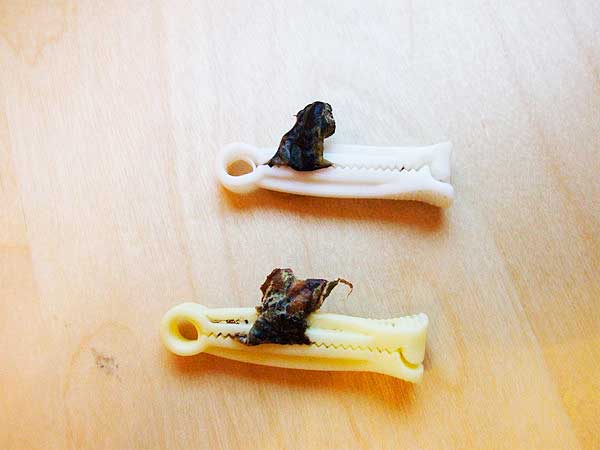
The state of the healing process of the navel is monitored until it is completely healed, especially after water procedures, once every ten days and at home.
If the crust is formed a little longer than usual, small discharges come out of it, the navel must be treated several times a day. The umbilical wound is smeared with "brilliant green", it is purchased at any pharmacy.
It happens that the navel under the clothespin is wet or covered with a yellow film. It's not scary, you need to continue processing, but instead of brilliant green, try chlorophyllipt, chlorhexedine. Medicines will relieve inflammation and disinfect the wound.
If the navel oozes from a newborn under a clothespin and does not heal, then a doctor's consultation is necessary.
When does the clothespin fall off the navel?
With daily treatment with antiseptics, the tip of the umbilical cord gradually dries. Shortly after birth, the dry part of the umbilical cord will fall off on its own. In its place, a small wound remains, which must be continued to be processed. The navel after the clothespin falls off looks like a regular wound.
What does the navel look like after the clothespin falls off:
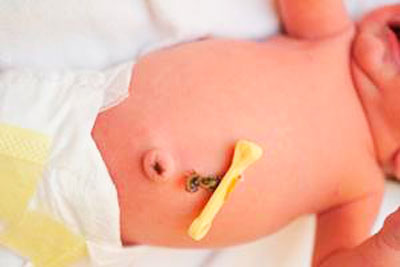
Photo of the navel after the clothespin fell off
When is the clothespin removed from the navel? The clothespin is not removed from the navel, it falls off by itself. This happens about a week after the baby is born. But this is not necessary, all children are different, so do not worry.
The navel without a clothespin remains 6-7 days after the baby is born. You do not need to remove the clamp yourself, wait until the umbilical process exfoliates itself.
How to remove a clothespin from the navel of a newborn? If the crust of the wound is no longer strong, it is better to carefully remove it, before that it is soaked with hydrogen peroxide (purchased at a pharmacy). At the same time, you should always check the expiration date of all drugs used.
How to handle the navel after the clothespin falls off?
When the clothespin fell off, an umbilical wound forms in its place, which is subject to daily care. The processing of the navel after the clothespin fell off remained practically unchanged. Still, the umbilical wound is first instilled with peroxide, dry crusts are removed with a cotton swab.
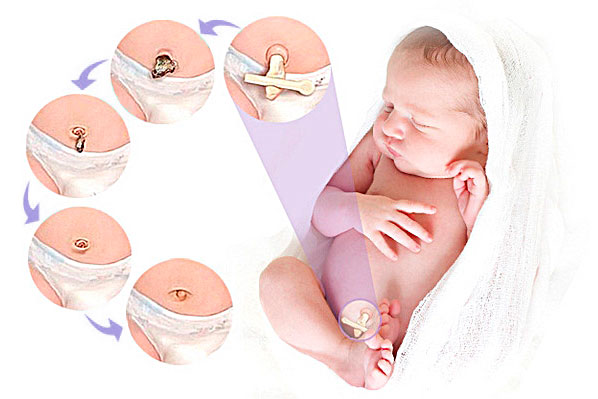
How does the clothespin fall off the navel?
The wound is dried and smeared with a solution of manganese, brilliant green, iodine. The navel of the newborn after falling off the clothespin becomes pink and covered with a film. If problems arise, the wound gets wet, oozes, then you can use chlorophyllipt, baneocin medicines or consult a doctor.
How to properly handle the navel of a newborn without a clothespin:
- hands are washed with soap before the procedure;
- spread the navel with two fingers and drip hydrogen peroxide;
- wait until the crusts get wet and carefully remove with a cotton swab. It is impossible to tear or cut off a dry crust;
- remove all liquid with a dry cloth or cotton pad;
- a disinfectant (brilliant green, iodine, manganese and others) is applied to the dry surface of the umbilical wound;
- only the wound needs to be treated, avoiding the area around it, so as not to burn healthy skin.
The whole procedure is carried out carefully, no need to rub the umbilical wound and press on it. After the procedure, let the baby lie down naked, the navel needs air for speedy healing. For the same reason, you can not seal the wound with a band-aid. When the diaper is put on, the belt can be tucked up so that the navel is not closed.

The navel of a newborn after a clothespin photo
How much to process the navel of a newborn after the clothespin falls off? Processing the navel in newborns with a clothespin takes about a week, on the 5th - 8th day, the clamp should fall off. After the clothespin has fallen off the navel, the wound is cared for until it is completely healed.
If the wound heals well, then 1 time per day is enough care. If problems arise, you need to consult a doctor and treat the wound 2 times a day.
With quality care, the wound heals in about 21 days. On the 21st - 23rd day, the dried remains of the "tail" of the navel fall off on their own. If the care was not entirely correct and the navel became inflamed, then the healing period is postponed indefinitely. To correct the situation, it is urgent to contact a pediatrician.
How to handle the navel after the clothespin falls off
It is necessary to process the navel of a newborn without a clothespin until the navel is completely tightened. Each baby is individual, the main thing is that there is no ichor, pus, an unpleasant smell, otherwise you need to see a doctor. If the navel with a clip was treated only with brilliant green, now other means can be used:
- solutions - hydrogen peroxide, iodine, manganese;
- medical preparations - chlorophyllipt, chlorhexedine, baneocin, fucarcin, furatsilin.
What tool to use when caring for the navel, the parents decide for themselves, be sure to consult with the pediatrician.
